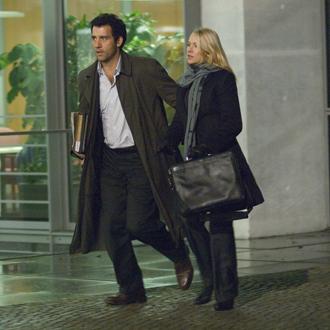- MENU
- HOME
- SEARCH
- WORLD
- MAIN
- AFRICA
- ASIA
- BALKANS
- EUROPE
- LATIN AMERICA
- MIDDLE EAST
- United Kingdom
- United States
- Argentina
- Australia
- Austria
- Benelux
- Brazil
- Canada
- China
- France
- Germany
- Greece
- Hungary
- India
- Indonesia
- Ireland
- Israel
- Italy
- Japan
- Korea
- Mexico
- New Zealand
- Pakistan
- Philippines
- Poland
- Russia
- South Africa
- Spain
- Taiwan
- Turkey
- USA
- BUSINESS
- WEALTH
- STOCKS
- TECH
- HEALTH
- LIFESTYLE
- ENTERTAINMENT
- SPORTS
- RSS
- iHaveNet.com: Movie Reviews

Some thrillers settle into a rut of adequacy, rarely spiking above or below the baseline.
Not "The International."
Director Tom Tykwer's new picture is all over the place, geographically and in terms of audience satisfaction. It's a case of creative interpreters working occasional pulp wonders with their own prosaic screenplay.
Valleys later, peaks first.
A global corruption travelogue, the film begins outside Berlin's Central Station.
It's raining.
We're inside a sedan where an American is meeting a shadowy Luxembourg financier. The hushed conversation concerns why the man's bank, the (fictional) I.B.B.C., is spending so many millions buying up Chinese-made weapons.
Suddenly the rain stops, in rather a sinister way.
Watching this encounter from across a busy street is an Interpol agent, played by Clive Owen, wearing an overcoat and a knitted brow.
The chaos that ensues is sharply effective, well-staged, well-edited, well-scored -- everything you want in an opener.
In a film that exists largely for its set pieces, the most flamboyant arrives at the two-thirds mark, and it's a dilly. Owen's character, Louis Salinger, a former Scotland Yard detective with a checkered résumé, has accompanied a couple of New York City cops to Frank Lloyd Wright's Guggenheim Museum.
They're tailing an assassin, played by Brian F. O'Byrne, who is meeting with another adviser to the I.B.B.C. He's portrayed by my current favorite character actor, Armin Mueller-Stahl, who deserves an Oscar for his work in "The International" simply for the timing and weary nonchalance he brings to the ellipsis in the phrase "Death ... comes for us all."
Designed to give architecture preservationists a heart attack, the Guggenheim shootout begins simply and escalates alarmingly. It manages a remarkable feat: It intercuts location shots of the actual museum's exterior (and, I think, a bit of the interior) with a fabulous mock-up built and then shot all to hell in a factory in Germany. Director Tykwer, who made his international name with the zingy "Run Lola Run" before moving on to, among others, the malodorous "Perfume," reminds us here how good he is with complex cinematic mayhem. For the prologue and the Guggenheim scene alone, "The International" merits a look.
Getting in and out of such sequences, however, which include an assassination at a Milan political rally, is not the film's strong suit.
For two years, Owen's Interpol agent and his ally in the Manhattan district attorney's office, played by Naomi Watts, have tried to bust this bank's nefarious doings wide open. (Screenwriter Singer based his story on the BCCI banking scandal of the early 1990s.)
The many-tentacled organism, whose managers are perpetually taking meetings in high-ceilinged, vaguely threatening offices, foments revolution in one country while mucking around with organized crime in another.
Certainly this is an apt time to release a thriller whose villains all work for a bank, especially a bank so arrogant in its murderous lack of scruples. But "The International" plods between action sequences. The bank's evildoing is taken for granted early on and never develops any wrinkles or narrative surprise, and while the script's intent is to paint a backdrop of multinational, free-floating amorality, involving everyone but Mr. Owen's personal publicist, the dialogue is merely functional.
"We're just trying to get to the truth!' Watts asserts at one point, saying something no actor should have to say, ever. (You'd never know from this performance how good Watts really is.) Elsewhere Owen levels her with the line: "Sometimes the hardest thing is to know which bridge to cross, and which one to burn. I'm the one you burn." The look Watts gives him in return betrays a hint of: Not sure I caught your metaphor.
Still, I wonder if audiences half-expect klutzy, formulaic dialogue if only because they've been hearing it all their moviegoing lives. There are compensations here, starting with the reassuring gloss and elegance to the surfaces of "The International."
While its globe-trotting itinerary recalls the mad whirl of a "Bourne" picture, nothing about this film's style resembles the second or third "Bourne" outings (which I loved). No documentary-style hand-held aesthetic here; no eye-blink edits or spatially dislocating compositions. Tykwer and cinematographer Frank Griebe keep their gaze steady, the colors steely gray and blue, the atmosphere classically forbidding. It's a nice change from the usual.
If only a filmmaker could send his film in for a script punch-up and polish after it was finished!
The International MPAA rating: R (for some sequences of violence and language)
Running time: 1:58
Starring: Clive Owen (Louis Salinger); Naomi Watts (Eleanor Whitman); Armin Mueller-Stahl (Wilhelm Wexler); Brian F. O'Byrne (The Consultant); Patrick Baladi (Martin White)
Directed by Tom Tykwer; screenplay by Eric Singer; photographed by Frank Griebe; edited by Mathilde Bonnefoy; production design by Uli Hanisch; music by Tykwer, Johnny Klimek and Reinhold Hall; produced by Charles Roven. A Columbia Pictures release
The International Movie Review - Clive Owen & Naomi Watts
© Tribune Media Services